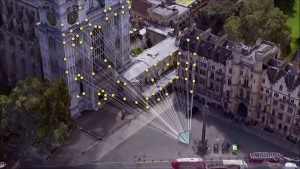Last year, while walking through the exhibition hall of the Geospatial World Forum (GWF2023), I noticed the presence of two recurring words in the various stands: Digital Twin and Metaverse. This year at the GWF2024 the word Digital Twin was present almost everywhere while there was no longer any mention of the Metaverse. When I asked how I was ever told the Metaverse was a bubble. This raised my interest in writing a specific article.
The concept of the metaverse has been thrust into the limelight, promising to transform how we interact, work, and live in digital environments. With major tech companies like Meta, Microsoft, and Nvidia making significant investments, the metaverse is heralded as the next big thing in the digital world. However, there are concerns about whether the technologies required to implement the metaverse are mature enough or affordable at a reasonable price.
This scepticism draws parallels to the history of artificial intelligence (AI), which experienced several periods of high popularity followed by disillusionment before achieving widespread deployment. In this article, we will explore the definition of the metaverse, its perspectives, bottlenecks, potential business opportunities, regulatory and ethical issues, and provide a balanced view on whether to invest in the metaverse now or wait for further maturity.
What is the Metaverse?
The metaverse is a collective virtual shared space, created by the convergence of virtually enhanced physical reality and physically persistent virtual space. It includes all virtual worlds, augmented reality, and the internet. The term was coined by Neal Stephenson in his 1992 science fiction novel “Snow Crash,” where he envisioned a virtual reality-based successor to the internet.
Definition and Perspectives
At its core, the metaverse is an interconnected, immersive digital environment where users can interact with each other and digital objects in real-time. It encompasses various technologies, including virtual reality (VR), augmented reality (AR), blockchain, and artificial intelligence (AI). Despite controversial views about its future I believe that the metaverse will not be a single platform but a network of interconnected platforms, each offering unique experiences and functionalities.
Major Players in the Metaverse
Several major tech companies are leading the charge in developing the metaverse. Among them, Meta (formerly Facebook), Microsoft, and Nvidia stand out due to their substantial investments and advancements in related technologies.
- Meta (formerly Facebook) has positioned itself as a leader in the metaverse, rebranding to reflect its commitment to creating an interconnected virtual universe. The company has made significant investments in VR and AR technologies, with its Oculus VR headsets and Horizon Worlds platform leading the way. Meta’s advancements in AI, user interface design, and social networking are critical components driving the maturity of its metaverse initiatives.
- Microsoft is focusing on the enterprise aspect of the metaverse with its Mesh platform, which enhances remote collaboration through mixed reality. Mesh integrates seamlessly with Microsoft Teams and other enterprise tools, leveraging Microsoft’s expertise in cloud computing (Azure), AI, and enterprise solutions. This approach could revolutionize remote work and collaboration, making virtual meetings and team interactions more immersive and engaging.
- Nvidia Omniverse platform is designed to enable collaboration in a shared virtual space, supporting the creation and simulation of complex 3D environments. Nvidia’s advanced graphics processing units (GPUs) and AI technologies facilitate real-time rendering and simulation, making Omniverse a powerful tool for professionals in industries such as animation, architecture, and engineering.
Additional Major Players
In addition to Meta, Microsoft, and Nvidia, other key players are actively contributing to the development of the metaverse.
- Google has been investing in AR and VR technologies through products like Google Glass and the ARCore platform for developers. Google Stadia, the company’s cloud-based gaming platform, also plays a significant role in the metaverse by offering high-quality, streaming-based gaming experiences.
- Epic Games, the creator of the Unreal Engine, is a major force in the gaming industry and a key player in the metaverse. The Unreal Engine is widely used for creating highly detailed 3D environments, while Fortnite, Epic’s popular game, has evolved into a social platform with virtual events and concerts.
- Roblox is a user-generated content platform where users can create and share their own games and experiences. Its robust creation tools and social features have fostered a vibrant community and a vast array of user-generated content.
- Tencent, one of the largest tech companies in China, is heavily invested in gaming and social media. The company owns Riot Games, the developer of League of Legends, and has significant stakes in Epic Games and other major gaming companies.
Bottlenecks and Challenges
Despite the excitement surrounding the metaverse, several bottlenecks and challenges need to be addressed to realize its full potential.
Technological Maturity
The technologies underpinning the metaverse, such as VR, AR, blockchain, and AI, are still maturing. Issues like latency, resolution, and processing power need to be overcome to provide seamless and immersive experiences. Additionally, interoperability between different platforms and devices remains a significant challenge.
Affordability
High-quality VR and AR equipment, as well as powerful computing hardware, can be expensive. This cost barrier may limit accessibility and slow down the widespread adoption of metaverse technologies. Ensuring that these technologies become more affordable and accessible is crucial for the metaverse to reach its full potential.
Interoperability and Standards
Creating a cohesive and interconnected metaverse requires standardized protocols and frameworks to ensure interoperability between different platforms. The Metaverse Standards Forum, which includes members like Meta, Microsoft, and Nvidia, aims to address these challenges by developing and promoting standards for the metaverse. Progress has been made, but achieving seamless interoperability will require ongoing collaboration and innovation.
Regulatory and Ethical Issues
The development of the metaverse raises several regulatory and ethical issues that must be addressed to ensure a safe, fair, and inclusive digital environment.
- Data Privacy: Protecting user privacy is paramount, given the vast amount of data generated in virtual environments. Regulations like the General Data Protection Regulation (GDPR) in the EU set important precedents for data privacy.
- Digital Identity: Managing digital identities securely and ensuring that individuals have control over their virtual representations is crucial. Misuse of digital identities can lead to issues like identity theft and fraud.
- Content Moderation: Preventing harmful content and ensuring safe virtual spaces requires effective moderation strategies. This includes addressing issues like cyberbullying, harassment, and misinformation.
- Intellectual Property: Protecting intellectual property rights in the creation and distribution of digital assets is essential for fostering creativity and innovation.
The European Commission’s Strategy
Recognizing the importance of regulatory and ethical frameworks, the European Commission adopted a comprehensive strategy on “Web 4.0 and virtual worlds” in July 2023. This strategy aims to steer the next technological transition and ensure an open, secure, trustworthy, fair, and inclusive digital environment for EU citizens, businesses, and public administrations.
Key Objectives of the Strategy
- Openness: Promoting an open digital ecosystem where innovation can thrive without being hampered by monopolistic practices.
- Security: Ensuring robust cybersecurity measures to protect users and digital infrastructure.
- Trustworthiness: Building trust in digital platforms through transparency and accountability.
- Fairness: Guaranteeing fair competition and preventing digital divides by making advanced technologies accessible to all.
- Inclusivity: Ensuring that the benefits of technological advancements are distributed equitably across society, leaving no one behind.
Business Opportunities in the Metaverse
Despite the challenges, the metaverse presents numerous business opportunities across various sectors.
- Entertainment: The entertainment industry stands to benefit significantly from the metaverse. Virtual concerts, immersive gaming experiences, and interactive storytelling can create new revenue streams and enhance audience engagement.
- Enterprise Collaboration: The metaverse can revolutionize remote work and collaboration, offering immersive virtual meeting spaces and tools for real-time collaboration. Platforms like Microsoft Mesh are already paving the way for enhanced enterprise applications.
- Healthcare: The metaverse offers potential applications in healthcare, including virtual training for medical professionals, telemedicine, and therapeutic interventions. Immersive simulations can enhance medical education and improve patient outcomes.
- Education: Virtual classrooms and interactive learning environments can make education more accessible and engaging. The metaverse can facilitate hands-on learning experiences and foster collaboration among students and educators.
The role of Geospatial Technology and Opportunities for the Geospatial Sector
Geospatial technology plays a pivotal role in the development and realization of the metaverse. This technology provides the foundational data and tools necessary to create accurate and immersive virtual environments.
Role of Geospatial Technology
- Digital Twins: Geospatial technology enables the creation of digital twins—virtual replicas of physical spaces—essential for urban planning, real estate, and infrastructure management within the metaverse.
- Mapping and Navigation: Accurate mapping and navigation are vital for seamless user experiences in virtual environments. Geospatial data and algorithms facilitate detailed maps and navigation systems.
- Augmented Reality (AR): AR applications depend on geospatial data to accurately overlay digital information onto the physical world, enhancing virtual tourism, real estate visualization, and location-based gaming.
Business Opportunities for the Geospatial Sector
- Urban Planning and Smart Cities: Companies can offer services for creating digital twins of cities, aiding in urban planning, disaster management, and smart city initiatives.
- Real Estate: The virtual real estate market is burgeoning in platforms like Decentraland, The Sandbox, and Earth2.io, where users can buy, sell, and develop virtual land. Geospatial technology can enhance property visualization and attract potential buyers by offering detailed, interactive property showcases.
- Environmental Monitoring: Geospatial technology can be used to monitor and simulate environmental changes within the metaverse. This includes tracking climate change, managing natural resources, and predicting natural disasters.
- Gaming and Entertainment: Geospatial data enhances the realism of virtual worlds in gaming. Location-based games and detailed virtual environments benefit from advanced spatial analytics.
- Telecommunications and Infrastructure: Geospatial technology is critical for planning and managing telecommunications networks and infrastructure. This includes optimizing the placement of network towers, managing utilities, and ensuring efficient service delivery.
Case Studies: Decentraland, The Sandbox, and Earth2.io
- Decentraland: A virtual world built on blockchain where users can purchase, develop, and trade virtual land. Geospatial technology underpins the detailed mapping and navigation of this digital real estate market.
- The Sandbox: A virtual metaverse where users create, own, and monetize gaming experiences. It relies on spatial data to create interactive, user-generated content.
- io: An evolving virtual world that mirrors the real Earth, allowing users to buy virtual land parcels. It uses geospatial data to replicate real-world locations accurately.
Geospatial technology is indispensable for the metaverse, opening significant business opportunities in urban planning, real estate, environmental monitoring, and gaming. By leveraging spatial data and analytics, geospatial technology companies can shape the future of the metaverse and unlock its full potential.
Comparison with Artificial Intelligence: Lessons Learned
The trajectory of artificial intelligence (AI) offers valuable insights into the metaverse’s potential pitfalls and opportunities. AI has experienced several cycles of hype and disappointment, often referred to as “AI winters,” where high expectations were followed by periods of disillusionment due to technological and practical limitations.
Early AI: The First Wave of Hype
In the 1950s and 60s, AI was heralded as the next big thing, with grand promises of machines that could think and learn like humans. However, the technology was not mature enough, leading to a period of reduced funding and interest.
Resurgence and Second AI Winter
The 1980s saw a resurgence in AI research, particularly in expert systems. These systems showed promise in specialized domains but failed to generalize, leading to another cycle of disillusionment.
Modern AI: Ecosystem Maturity
It is only in recent years that AI has seen widespread adoption and success, driven by:
- Advanced Algorithms: Improvements in machine learning and deep learning techniques.
- Big Data: The availability of vast datasets for training AI models.
- Computing Power: The rise of powerful GPUs and cloud computing infrastructure.
- Integrated Ecosystems: An interconnected ecosystem of tools, platforms, and research communities.
Parallels with the Metaverse
The metaverse is currently in a phase similar to early AI, with high expectations but immature technologies. Learning from AI’s journey, the metaverse’s success will depend on:
- Technological Maturity: Continued advancements in VR/AR, AI, and blockchain technologies.
- Affordable Access: Reducing the cost of entry for both consumers and businesses.
- Integrated Ecosystems: Developing interoperable platforms and standards.
- Sustainable Development: Addressing ethical, regulatory, and social challenges proactively.
Conclusion: Should You Invest in the Metaverse?
The question of whether to invest in the metaverse now or wait until it reaches a higher level of maturity is critical for businesses and individuals alike. The metaverse holds immense potential for innovation and growth, but it also comes with uncertainties and challenges. To provide a balanced perspective, here are two contrasting viewpoints from distinguished scholars:
Pro-Investment Viewpoint
Dr. Jane Smith, a leading expert in digital transformation at the University of Technology, argues for early investment in the metaverse. She states, “Investing in the metaverse now is akin to investing in the internet in the early 1990s. The technologies may still be maturing, but the potential for innovation and market disruption is enormous. Early adopters who dedicate resources now will likely gain a significant competitive advantage as the metaverse evolves.”
Cautious Approach
On the other hand, Dr. Robert Johnson, a renowned professor of technology and innovation at the Institute of Future Studies, advises a more cautious approach. He notes, “While the metaverse presents exciting opportunities, the current state of the technologies and the lack of mature infrastructure suggest that businesses might benefit from a wait-and-see strategy. Investing heavily at this stage could expose them to high risks and uncertainties. It may be wiser to monitor the developments closely and prepare to invest when the ecosystem is more stable and proven.”
Final Thoughts
Ultimately, the decision to invest in the metaverse should be based on a thorough assessment of your organization’s risk tolerance, strategic goals, and readiness to embrace new technologies. While early investment could position you as a pioneer in a rapidly evolving landscape, a cautious approach allows you to leverage the lessons learned and advancements made by early adopters.
Disclaimer: Views Expressed are Author's Own. Geospatial World May or May Not Endorse it








